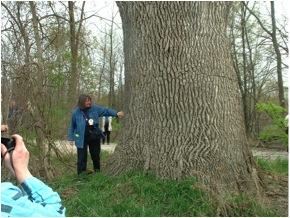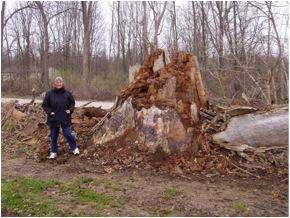Decisions and delays that undermine vital phytosanitary programs …
Michigan’s champion green ash – before and after emerald ash borer entered the state
Examples:
Sometimes, when a shipment arriving at a U.S. port is found to be enclosed in wood packaging that is infested by pests, the importers complain to top-level officials. Sometimes, those officials respond to the pressure by allowing that shipment to enter the country – contrary to policy and common sense.
I learned recently of a particularly upsetting situation. A shipment of car parts arrived at a seaport. The wood packaging was found to be infested by a wood-boring insect that attacks pines and possibly other conifers. Because adults were present, the shipment could not be fumigated – because adult insects can escape during that process.
According to U.S. regulations, the shipment should have been refused entry to the U.S. and placed back on the ship to be transported elsewhere.
But what happened instead? The importer – a major auto manufacturer – complained to Michigan political leaders that delay in receiving the “just in time” shipment would result in halting production and unemployment.
Michigan governor Snyder and both Senator Debbie Stabenow and Senator Gary Peters put pressure on the U.S. Secretaries of Agriculture (who supervises APHIS) and Homeland Security (who supervises the Bureau of Customs and Border Protection). The two secretaries agreed to allow movement of the pest-infested shipment from the seaport across half the country to Michigan. They overruled their staffs and endangered our forests – most immediately along the shipment route. Those forests provide wildlife habitat, carbon sequestration, water supplies and other ecosystem serves; as well as numerous jobs and industries. It will be years before we know whether pests escaped the containers during transport and established in any of the wildland, rural, or urban forests along the route.
Had the shipment been refused entry — as the law requires — a new shipment in pest-free crates would have arrived within weeks.
It is particularly ironic that this pressure was exerted by Michigan officials. You would think that Michigan officials would remember the devastation to their state caused by the emerald ash borer and — instead — press for vigorous enforcement of effective phytosanitary rules.
Of course, the Federal officials responsible for protecting our Nation from damaging plant pests should be strong in the face of political pressure. They should enforce regulations adopted through the appropriate regulatory processes. However, in this case, they chose the politically expedient action instead of carrying out their legal responsibilities.
A second example:
Since 2010, APHIS and its Canadian counterpart, Canadian Food Inspection Agency, have tried to amend the two countries’ regulations to require that wood packaging used to support or contain goods traded between the two countries conform to the international standard (ISPM#15). (When they initially adopted ISPM#15 in 2004, the U.S. and Canada exempted their bilateral trade.)
Why end this exemption? Both countries realize that each country harbors pests – native or introduced – that could pose a threat to forests in the other country. Also, the exemption complicates enforcement of the standard for shipments that originated elsewhere, e.g., in Europe or Asia.
For example, shipments of Italian decorative tiles that had been held in Canadian warehouses have been sent later to retailers in the U.S. Shippers have claimed that the pallets supporting the tiles are of Canadian origin, so they don’t need to have the stamp certifying treatment. Customs officials say that sometimes the evidence counters this claim – leading them to conclude that the pallet actually accompanied the load of tiles throughout its movement from Italy and thus is in violation of both U.S. and Canadian rules. I expect that Canadians could cite examples of the same problem arising with shipments from U.S. warehouses to Canadian retailers.
Still, despite the need to end the exemption, APHIS’ proposed rule has been stuck at higher levels in the Department of Agriculture due to opposition by the Chamber of Commerce and some business associations.
Why are top-level politicians and other officials undermining phytosanitary programs? Do they not know the costs they’re risking?
I think it is at least partly because those of who know about the pest risk associated with wood packaging lack powerful and vocal allies who can educate the policy-makers about the damaged caused by introduced tree-killing pests.
For a reminder – woodborers have been estimated by Aukema et al. 2011 to cost local governments $1.7 billion per year; homeowners pay another $760 million to remove dead trees from their property. For more information, see also my blogs posted in July, August, September, and October 2016; fact sheets posted here and articles by Aukema et al. 2011 and Lovett et al. 2016. Remember that the costs discussed in these papers don’t reflect the vast majority of environmental and ecosystem losses, including disruption of such unique ecosystems as black ash swamps from New Brunswick to Minnesota and tree hammocks in the Everglades. Nor do they include the losses of cultural resources to Native Americans, such as basket weavers of the North and medicinal plants for Tribes in Florida …
You would think that federal and state officials who have lived through the disasters resulting from introduced wood-borers would want strict enforcement of customs and plant health regulations intended to prevent introduction of additional tree-killing pests. But these people respond to what they hear from the public and the media – perhaps the loudest voice they heard most recently. Unfortunately, people who care about invasive species – specifically tree-killing insects and pathogens – don’t have spokespeople.
Do you think the President or even Secretary of Agriculture is hearing about tree-killing pests every week? From whom? Not the Chief of the USDA Forest Service. Not the forest products industry. Not leaders of conservation organizations. Do governors, mayors, or heads of state agriculture or conservation agencies speak to Senators or Members of Congress — routinely and repeatedly — about the need to better protect our forests from non-native pests?
The evidence is that they do not. And what is the result? These decision-makers respond to pressure from importers who want access to traded goods – and who are quite vocal about their complaints. Politics is how our country makes important decisions. And in politics, the squeaky wheel gets the grease.
When was the last time any of these officials – USDA Secretary Vilsack, DHS Secretary Jeh Johnson, Governor Rick Snyder, Senators Stabenow and Peters – heard from constituents or from leaders of the agencies under their jurisdiction about the importance of preventing introduction of new wood-boring insects? When did a Michigan news media outlet last publish a report that discussed the pathways or vectors by which these insects enter the country and the importance of enforcing rules adopted to prevent additional introductions?
I recognize that it can be difficult for staff to get the attention of their supervisors on such issues. For example, I have been told by several people that California Governor Jerry Brown was surprised to learn that sudden oak death had killed millions of trees in his state. How did he “learn” this? From an article in the Washington Post that reported on a recent scientific study (Cuniffe et al. 2016). Staff of CalFire were very frustrated that their efforts to educate the Governor had not resulted in his understanding the pathogen’s impact.
So – what can we do to re-balance the politics of phytosanitary policy – so that our political leaders understand why phytosanitary rules are adopted and support both adoption and enforcement of strong, effective measures?
We need to
- Speak up at every opportunity about the damage to our trees caused by non-native insects and pathogens and describe the policies and programs that can reduce that damage and the risk of additional introductions.
- Tell this story to elected officials at all levels
- Write letters to the editors of media outlets
- Offer to show officials and reporters examples of the damage
- Educate members of other stakeholder groups and ask them to integrate this message into their interactions with officials and the media.
Remember:
- Election seasons provide opportunities to raise issues.
- People taking up positions in January (whether elected or appointed) will be more open to learning about “new” issues than have been people who have occupied an office for some time.
Finally – these messages need to be repeated periodically. Proctor and Gamble does not make its profits by asking us to buy their toothpaste once a year. We cannot duplicate a major corporation’s advertising budget – but we can speak up!
SOURCES
Aukema, J.E., B. Leung, K. Kovacs, C. Chivers, K. O. Britton, J. Englin, S.J. Frankel, R. G. Haight, T. P. Holmes, A. Liebhold, D.G. McCullough, B. Von Holle.. 2011. Economic Impacts of Non-Native Forest Insects in the Continental United States PLoS One September 2011 (Volume 6 Issue 9)
Cunniffe, N.J., R.C. Cobb, R.K. Meentemeyer, D.M. Rizzo, and C.A. Gilligan. Modeling when, where, and how to manage a forest epidemic, motivated by SOD in California. PNAS, May 2016 DOI: 10.1073/pnas.1602153113
Lovett,G.M., M. Weiss, A.M. Liebhold, T.P. Holmes, B. Leung, K.F. Lambert, D.A. Orwig, F.T. Campbell, J. Rosenthal, D.G. McCullough, R. Wildova, M.P. Ayres, C.D. Canham, D.R. Foster, S.L. LaDeau, and T. Weldy. 2016. Nonnative forest insects and pathogens in the United States: Impacts and policy options. Ecological Applications, 0(0), 2016, pp. 1–19. DOI 10.1890/15-1176.1
Posted by Faith Campbell

